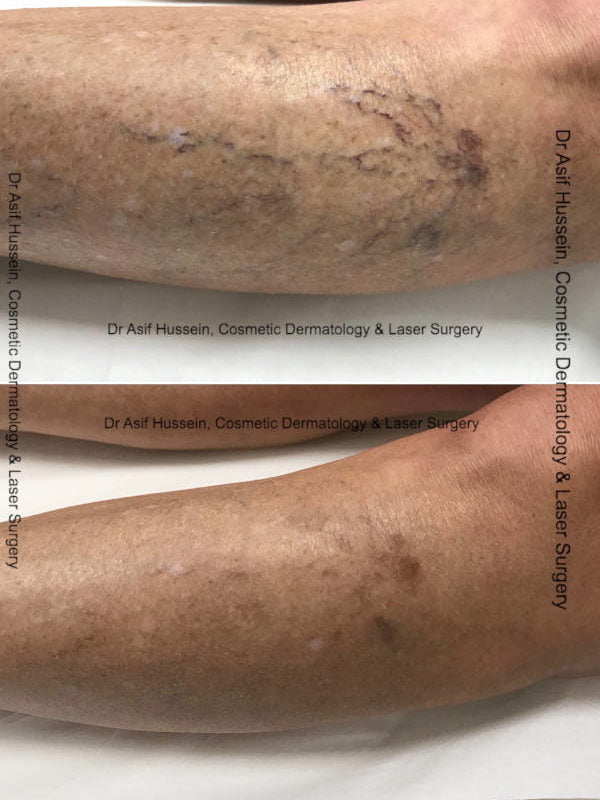INTRODUCTION
Leg veins are a term given to all wide variety of unsightly vein problems. When we talk about the treatment of leg veins in cosmetic dermatology we are often talking about the treatment of three types of unsightly veins.
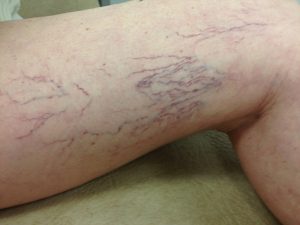
Telangiectasia (Spider Veins)
These are the most common unsightly veins that clients wish to have treated. They usually are purple to black in colour and 0.5 – 1.5 mm in diameter. They can be treated effectively with a combination of sclerotherapy and laser treatment.
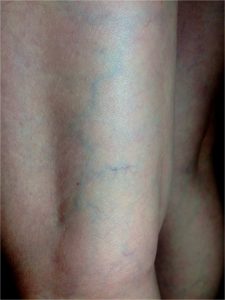
Reticular Veins (Flat feeding Vessels)
These are the veins that may also have to be injected as they feed the webs of spider veins. Without sealing them off treatment of spider veins can be short lived. These are usually injected with a higher concentration sclerosant or foamed sclerosant.
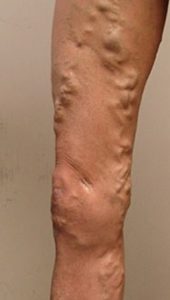
Varicose Veins
These are raised large diameter veins that bulge out from the skin surface.
These veins are like the veins of a lean muscular bodybuilder. They tend to be large and bulge under the skin. However, they tend to be found on the legs of normal individuals rather than the arms of bodybuilders!
TREATMENT
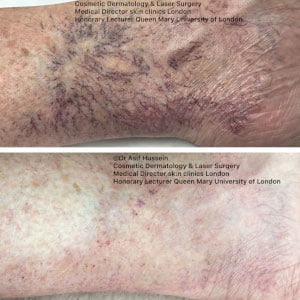 To understand more about leg vein treatment using laser and sclerotherapy, please take the time to look at Dr Hussein’s lecture included in this section.
To understand more about leg vein treatment using laser and sclerotherapy, please take the time to look at Dr Hussein’s lecture included in this section.
Following a consultation, history and examination. Dr Hussein will undertake the treatment of uncomplicated Telangiectasia (spider veins) and Reticular veins at his sk:n clinic. Depending on the size and distribution of the veins he will use a combination of Sclerotherapy and Long pulsed Nd-YAG laser to clear as many veins as possible.
Number of treatment sessions that are required depends on the extent, size and distribution of leg veins. This typically varies from 1-3 sessions to see an 80% improvement in veins.
Varicose veins need to be dealt with in a slightly different way. The interventions require image guidance with ultrasound and more invasive methods. Dr Hussein works in partnership with The Harley Street Vein clinic where patients can undergo ultrasound and Endovenous Laser Ablation (EVLA) of varicose veins as a day case procedure.
Leg veins are tough to treat. This is due to vein recovery potential. Legs are slow to heal as well so when planning a treatment make sure it is done several months prior to summer holidays. To reach optimal results can take as long as three months post treatment. Winter treatment for the following summer is advised.
Selection of appropriate cases is important. Attempts to treat very fine spider veins of 0.3mm diameter and below are often futile because it is quite simply not possible to get the sclerotherapy needle into the vessel. Laser is also difficult for very small vessels as they require high fluence treatment with short pulse widths. Put simply the potential side effect risk when using laser for very fine vessels of 0.3mm and below would result in an unsatisfactory outcome and potentially worse cosmetic outcome when compared to the pre-treatment appearance.
In short if you have good eyes and you have to look at your legs up close (less than 30cm away) then it is too early to come and see Dr Hussein for leg vein treatment. Wait until they become more visible!
Laser in Vein Treatment
Many patients assume that laser treatment is the same. However there are multiple different types of laser & light devices that are used to treat (or attempt to treat) leg veins. Now if you happen to be an expert in cutaneous laser surgery such as Dr Hussein then rest assured the most appropriate devices will be selected. The most effective laser in treatment of leg spider veins is the long pulsed NdYAG. This is because it has a wavelength (1064nm) that will penetrate deep enough to seal the spider vein. Diode lasers (810-940nm) can also be reasonably effective but carry a slightly higher risk of skin pigmentation change. Pulsed Dye Laser (585-595nm) and KTP (532nm) are useful in treating very fine superficial vessels but usually insufficient for most leg spider veins. Intense Pulsed Light devices (usually falsely called Laser) are low powered devices that are not highly effective in the treatment of leg veins. Dr Hussein has access to all wavelengths as he has multiple devices. Due to the high cost of lasers many clinics will try and adopt a one machine fits all approach.
POTENTIAL COMPLICATIONS
- Post Inflammatory Hyperpigmentation (30% of cases) – This is a common complication but fortunately in over 90% of cases it will completely settle within 2-3 months. Incidence of PIH can be reduced by wearing class 2 compression tights for 3 days post treatment. It can happen with sclerotherapy and laser treatment.
- Matting (20% of cases) – This is effectively the tendency of the body to respond to destruction of veins by forming small new veins. Basically neovascularisation. As a result pink patches of new veins (Telangiectatic matting) tend to form after treatment. These usually spontaneously regress after a few months. If there is persistence the Pulsed Dye Laser or long pulsed NdYAG can be used to help reduce the appearance. It can happen with laser and sclerotherapy treatment.
- Ulceration (Less than 1% but more likely near the ankles and inner thigh near the knee) – This is a rare complication of sclerotherapy but can happen with sclerotherapy only. It occurs when sclerosant finds its way into a dermal arteriole rather than a vein. This is more likely to happen near the ankle with sclerotherapy due to the anatomy of the veins and arteries in this region. This is why Dr Hussein prefers to use laser in this region. If ulcers form they are usually a bit painful and take 6 weeks to heal but scarring is actually minimal and acceptable. Usually these ulcerations are no more than 5mm in width.
- Deep Vein Thrombosis (DVT) (1 in 1000) – It is a risk of sclerotherapy only. Mercifully this is a rare complication. It is more likely in the following groups of people:
- Smokers
- Oral Contraceptive pill use
- Overweight/Obese
- Previous history of clots or family history
- Cancer sufferers
- People with reduced mobility
- Diabetics
- Heamosiderin Deposition – Again quite a rare complication but one that can cause what appears to be a more longstanding/permanent bruise due to leakage of iron containing pigment from treated veins. Unfortunately this is difficult to predict but thankfully relatively rare. It can also be treated with laser if it occurs. It is more likely to occur from sclerotherapy not laser
- Burn (1 in 1000) – Burns can arise from lasers only. The incidence of this is user dependent. Dr Hussein is a specialist in cutaneous laser surgery and performs in the region of 1500-2000 laser cases a year. He is also a Clinical Lecturer in Cutaneous Laser Surgery at Barts & The London School of Medicine & Dentistry. Therefore when it comes to laser you are in knowledgeable and safe hands with Dr Hussein.
AFTERCARE
If you have had an injectable microsclerotherapy treatment today, please observe the following:
- It is advisable to undertake mild exercise (e.g. a 30 minute walk or gentle bike ride) twice a day for one week after treatment. This helps the injected veins to constrict and improves the efficacy of the treatment. Please note that exercise should not be too vigorous as this can have a detrimental effect.
- Leave the dressings/cotton balls and tape on until bedtime. If you develop an itching or burning sensation in the area of the dressings please remove them immediately.
- Please wear firm support tights or class 1 thigh length compression stockings immediately after treatment and for up to 7 days following this treatment. This enhances the efficacy of the treatment. If you can tolerate continuous wear for the first 3 days then do so. If this is difficult then remove them at night.
- Avoid hot baths/showers for 7 days after treatment. Use lukewarm water for baths/showers for the first 7 days after treatment.
- Please avoid sun exposure to your legs for the next 6 weeks.
- If you experience any darkening of the injected areas (hyperpigmentation) you must avoid sun exposure for at least 12 months. Please inform your practitioner if this occurs.
- If you have any further questions or experience any undesirable side effects please contact your practitioner as soon as possible for further advice. Please note that if you have any shortness of breath / calf or leg swelling / leg pain it is important to immediately attend your local A&E to exclude a DVT and/or PE.
- Please note that the healing process following microsclerotherapy can take up to several weeks. You may experience tenderness, discolouration, hardening or the development of tiny red spider veins (matting). These conditions will resolve spontaneously but may take a few months.
- When returning for your next treatment, do not shave the legs for at least 24hrs prior to treatment. Do not use any lotion or cream on the legs on the morning of treatment.
- Avoid air travel for four weeks post treatment.
- Please call if you have any further questions. Contact details below.



